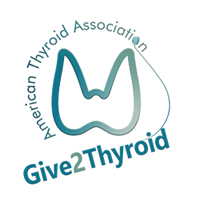ABBREVIATIONS & DEFINITIONS
 Hypothyroidism: a condition where the thyroid gland is underactive and doesn’t produce enough thyroid hormone. Treatment requires taking thyroid hormone pills.
Hypothyroidism: a condition where the thyroid gland is underactive and doesn’t produce enough thyroid hormone. Treatment requires taking thyroid hormone pills.
Levothyroxine (T4): the major hormone produced by the thyroid gland and available in pill form as Synthroid™, Levoxyl™, Tyrosint™ and generic preparations.
Thyroid hormone therapy: patients with hypothyroidism are most often treated with Levothyroxine in order to return their thyroid hormone levels to normal. Replacement therapy means the goal is a TSH in the normal range and is the usual therapy. Suppressive therapy means that the goal is a TSH below the normal range and is used in thyroid cancer patients to prevent growth of any remaining cancer cells.
TSH: thyroid stimulating hormone — produced by the pituitary gland that regulates thyroid function; also the best screening test to determine if the thyroid is functioning normally.
Thyroxine (T4): the major hormone produced by the thyroid gland. T4 gets converted to the active hormone T3 in various tissues in the body.
Autoimmune thyroid disease: a group of disorders that are caused by antibodies that get confused and attack the thyroid. These antibodies can either turn on the thyroid (Graves’ disease, hyperthyroidism) or turn it off (Hashimoto’s thyroiditis, hypothyroidism).
Goiter: a thyroid gland that is enlarged for any reason is called a goiter. A goiter can be seen when the thyroid is overactive, underactive or functioning normally. If there are nodules in the goiter it is called a nodular goiter; if there is more than one nodule it is called a multinodular goiter.
Thyroid Ultrasound: a common imaging test used to evaluate the structure of the thyroid gland. Ultrasound uses soundwaves to create a picture of the structure of the thyroid gland and accurately identify and characterize nodules within the thyroid. Ultrasound is also frequently used to guide the needle into a nodule during a thyroid nodule biopsy.




